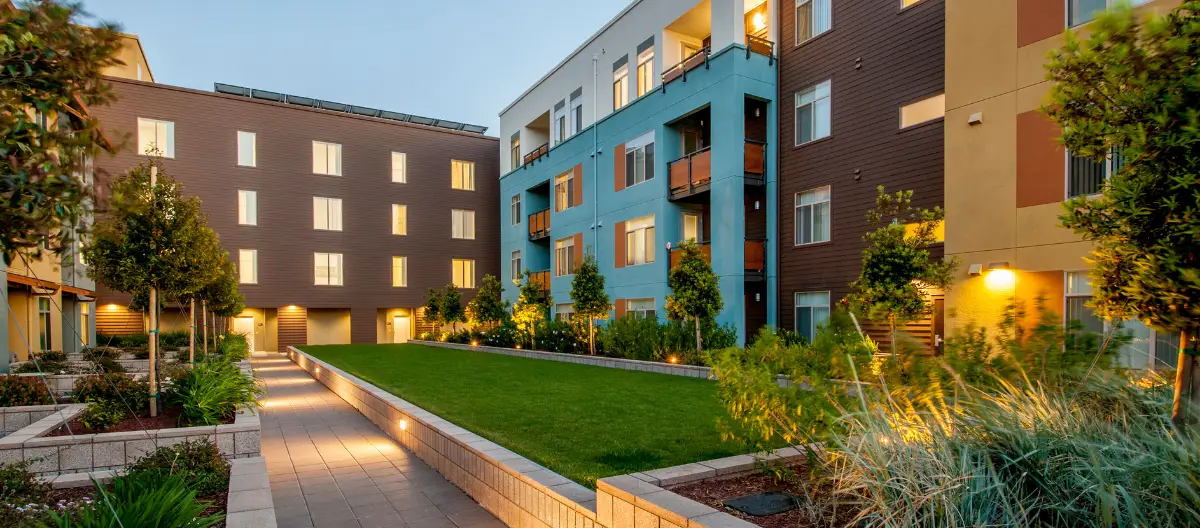If you’re new to the social care world, trying to understand different types of care and support can feel daunting. What is residential care? What is supported living? And finally, what is domiciliary care?
Here, we’ll explain the difference between supported living and residential care, and who can benefit from each.

Table of Contents
What is residential care?
Residential care might also be described as care homes, nursing homes or residential homes.
In a care home, residents receive care in a dedicated facility. There will be staff on-site 24 hours a day.
Most people living in residential care receive personal care. This may include help with washing, getting dressed, going to the toilet, or taking medication. Each resident will have a personalised care plan which explains how care workers will support them.
Staff look after domestic tasks, such as cleaning, gardening, and meal preparation. They serve meals and support residents with eating if necessary, either in a communal dining room or to a resident’s own room.
People living in residential care usually have one bedroom, sometimes with an en-suite. There will also be communal areas, such as a dining room, activity room, and gardens.
Residential care homes usually have a selection of activities available, and may run day trips or bring in entertainment.
Care home technology, like emergency alarms, smart speakers and AI assistants, and care management software may also be used.
Who works in a residential care home?
Staff in a care home may include:
- Care workers (possibly called carers, support workers, or personal assistants), who provide personal care for residents
- Activity co-ordinators, who arrange entertainment, activities, and trips
- Nurses, who provide nursing care where necessary
- Housekeeping staff, who provide cleaning and other necessary services
- Chefs, who prepare and serve food
- Administrative staff, who may arrange recruitment, liaise with the local authority, and deal with financial matters
- A care co-ordinator or supervisor, who schedules care calls, plans staff training, and manages other care staff
- A registered manager, who is responsible for the overall service
Other healthcare professionals, such as pharmacists, GPs, and district nurses, will also probably visit regularly.
Coproduction -where multiple care teams come together to provide care – is common in care homes and social care as a whole.

Who might need residential care?
Many people living in care homes have mobility difficulties or complex health conditions. They may need personal care throughout the day and night, or nursing support.
Residential care may be helpful for people with dementia, or certain mental health or learning difficulties. It’s especially useful if the person would struggle to live safely in the community, or if they can no longer live with family members or a partner.
Some people may need residential care for a short time—perhaps after a hospital discharge, or as respite care if their usual carer is unavailable. For others, residential care is a long-term choice.
What are the different types of residential care?
Depending on the person’s needs, there are several types of specialised residential care.
- Residential homes, where residents receive personal care only. These homes do not provide nursing care.
- Nursing homes, where at least one trained nurse is available 24 hours a day. These homes are most suitable for people who need medical attention regularly.
- Dementia care homes, where most or all of the residents have dementia. They may run regular reminiscence groups, have extra security to prevent residents wandering and getting lost, and have staff with extra training in supporting people with dementia.
- Dual registered care homes, where some residents receive nursing care and others receive personal care only. These homes allow people to remain in one place even if their needs increase greatly.
Is residential care right for me?
Care homes can be excellent for lots of people. However, if you’re trying to weigh up supported living vs residential care, there are also some points to consider.
- Cost: Unfortunately, residential care can be expensive. Many people receive funding from their local authority or the NHS to support their care. However, for people who are not eligible for funding, care home costs can quickly add up.
- Loss of independence: Many people enjoy keeping to their own routines, making their own meals, and making lots of decisions independently. While most care homes encourage residents to be as independent as possible, it can be difficult for some people to adjust to having food prepared for them and working with other people’s routines.
- Lack of personal space: If someone has been used to living in their own house or flat, having only one or two rooms to themselves can be a big adjustment.
- Stressful move: For many people, moving house is one of the most stressful events in their life. Moving into a care home, especially while living with a diagnosis of dementia or dealing with declining health, can be especially traumatic.
- Possible separation from partner, pets, and family: If the person is used to living with a partner, pets, or other family members, they may need to leave them behind when moving into residential care.
What is supported living?
Supported living is an alternative to residential care for many people. It provides a more independent way of life, but can support people who can’t, or don’t want to, continue living in their own home.
Supported living might be called several other names, including:
- Housing with support
- Assisted living
- Sheltered housing
- Extra-care housing
Most people in supported living schemes have their own property—usually an apartment or bungalow. They can usually continue to live with their partner, and may be able to bring pets.
Supported living properties usually have at least one bedroom, a bathroom, kitchen, and living area. There may also be communal areas, such as activity rooms, gardens, or dining rooms.
Some supported living properties are available for rent only, whereas others are also available for sale or shared ownership.
Staff are available to help residents in an emergency. They may also provide personal care, but probably less than in a care home. Nursing care or advanced dementia care is not usually provided.
Like care homes, assistive technology is now commonplace in supported living facilities. For example, you may find alarm and sensor systems, and staff may use supported living software to plan care and schedule check-ins.

Staff in supported living
Supported living schemes vary in scope. Most schemes will have at least one member of staff on site in case of an emergency 24 hours a day.
Supported living schemes may also have the following staff:
- Care workers, who can provide scheduled care visits and help in an emergency
- Activity co-ordinators, who arrange activities and entertainment
- Housekeeping staff, who clean the communal areas and possibly residents’ own properties
- Chefs, who prepare and serve food in communal dining areas
- Administrative staff, who deal with HR, financial and legal matters
- A care co-ordinator or supervisor, who schedules care calls and plans staff training
- A registered manager, who is in charge of the scheme
Who might need supported living?
Different supported living schemes may be suitable for different groups of people—for example, specifically for people over 60, autistic people, or people with learning difficulties.
Lots of people who move into supported living don’t need a lot of care. Many want peace of mind, knowing that there are staff available in case of an emergency.
Some people may choose to move to a supported living facility so they can enjoy the amenities, or to be around other people and avoid loneliness, even if they don’t have any care needs.
Downsizing to a smaller property can make life easier and avoid injuries when gardening, climbing stairs, or trying to clean a large house. If someone has mobility difficulties, a supported living scheme is likely to be wheelchair-accessible.
Moving to a supported living scheme before you have extensive care needs can avoid the need to move to residential care in the future. However, depending on their needs, some residents may still need to move to a care or nursing home as time goes on.
Other people may move to supported living if they are unable to live alone but want to live as independently as possible—for example, if they have learning difficulties.
When supported living might not be the right option
Supported living can be a great choice for many people. However, when deciding between supported living, residential care, and domiciliary care, it’s important to consider some challenging aspects of supported living.
- Stressful move: As with moving to residential care, any house move can be stressful.
- Not always a home for life: If their needs increase, some supported living residents may need to move to residential care in the future. A second move, especially during a health crisis, could be very traumatic.
- Additional costs: Services such as care, meals, and cleaning may not be included in the base cost of supported living schemes. These additional costs can add up.
- Selling the property: If the resident purchases their property, they or their next of kin may need to sell it in the future. This can be stressful and take a long time, depending on local demand.
What’s the difference between supported living and residential care?
If you’re looking at supported living vs residential care, there are a few main differences:
- Staffing: In residential care, there will usually be more care staff available, and they may provide more services for residents. However, in supported living environments, there won’t be as many staff available 24/7.
- Care and nursing needs: Many supported living schemes provide some care, but if a resident needs 24-hour support or intensive nursing care, they may need to move to residential care.
- Independence: In a supported living scheme, residents will have their own apartment or bungalow, so can set their own schedule and choose their own meals. In a care home, with more communal facilities, this may be more difficult.
- Staying with a partner: Lots of supported living schemes will let a couple move in together. However, many care or nursing homes have single-occupancy rooms only.
- The amount of space available: Most nursing and care homes provide a private bedroom and possibly an en-suite. However, supported living schemes usually offer an entire bungalow or apartment for residents.
- Property ownership: Some supported living schemes allow residents to purchase a property.
What’s the difference between supported living and domiciliary care?
As well as looking at supported living vs residential care, there is a third option: domiciliary care.
Domiciliary care is where a carer or personal assistant visits someone in their home to provide care and support. It might also be called home care or care at home. Some people may need a drop in visit a couple of times a week, whereas others might need regular care throughout the day and night.
It can be a good option for people who need more support, but who don’t want to leave their current home.
People generally choose these services because they value their independence. However, there are a few key differences between supported living and domiciliary care:
- Location: Domiciliary care takes place in the person’s own home, whereas someone must move to a supported living scheme to take advantage of their services.
- Care available: A supported living scheme may have a limit to the amount of care hours they offer. However, home care can be provided 24 hours a day, if necessary.
- Companionship: People living in a supported living scheme can benefit from the company of other residents around them.
- Other services available: Supported living schemes may offer other activities, trips, or entertainment. Domiciliary care services won’t provide this.
For additional security and peace of mind, assistive technology solutions, like smart voice assistants and specialist home care management software, is commonly available.

Supported living vs residential care vs domiciliary care
There are many differences between the three types of care. However, at their heart, all support services should provide person-centred care.
When deciding between these services, it’s important to take the person’s care needs into account. However, it’s also vital to consider their goals and hoped-for outcomes. Where would they prefer to live? Is it important to them that they continue to live with a partner or their? Do they want to continue preparing their own food?
There’s no right choice—each service might be perfect for a different person.





